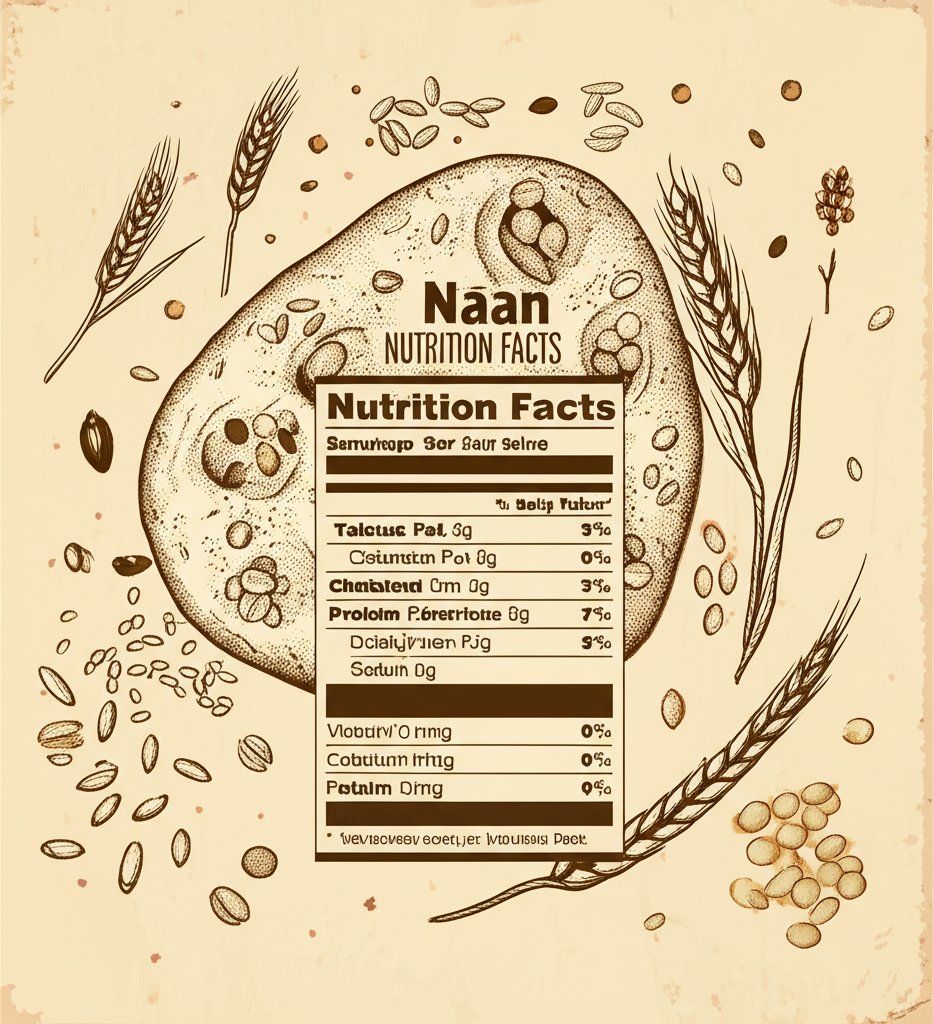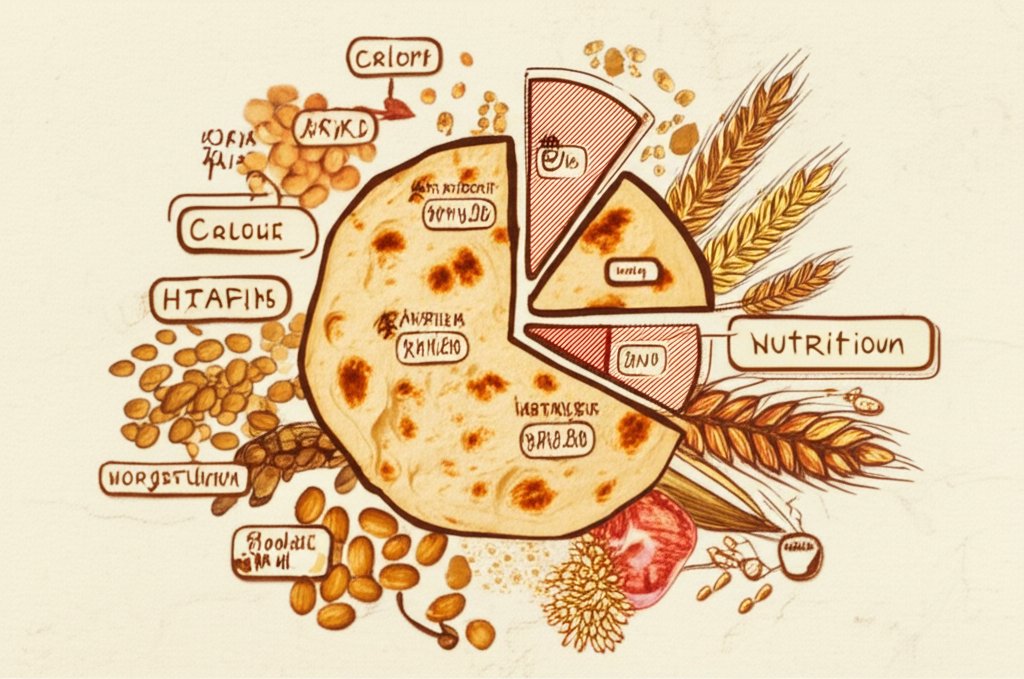Naan Nutrition Facts: What’s Inside Your Favorite Flatbread?

Ever wondered what makes that warm, pillowy naan so irresistible? Beyond its delicious taste and perfect texture for scooping up curries, understanding the naan nutrition facts is key to enjoying it as part of a balanced diet. It’s more than just empty carbs – it packs a mix of nutrients.
At a glance:
- Understand the key nutritional components of naan bread (calories, carbs, fat, protein).
- Learn how naan compares to other flatbreads in terms of nutrition.
- Discover ways to enjoy naan as part of a healthy meal.
- Debunk common myths about naan and its impact on your health.
- Get practical tips for choosing healthier naan options.
The Building Blocks: A Naan Nutrition Breakdown
Naan’s nutritional profile varies based on ingredients and preparation methods, but here’s a general overview per typical serving (around 2-3 oz or roughly half a large naan):
- Calories: 150 – 250
- Carbohydrates: 25 – 40g
- Protein: 4 – 7g
- Fat: 2 – 5g (can be higher depending on butter or ghee)
- Fiber: 1-2g
- Sodium: Varies widely based on recipe
Key Takeaway: Naan is primarily a source of carbohydrates, offering a moderate amount of protein and a small amount of fat. Sodium content can be significant, so be mindful of this if you’re watching your salt intake.
Naan vs. the Competition: Comparing Flatbread Nutrition
How does naan stack up against other popular flatbreads? Let’s compare a few common options:
| Flatbread | Calories (per serving) | Carbs (g) | Protein (g) | Fat (g) | Fiber (g) | Sodium (mg) |
|---|---|---|---|---|---|---|
| Naan | 150-250 | 25-40 | 4-7 | 2-5 | 1-2 | Varies |
| Pita Bread | 140-170 | 28-35 | 5-6 | 1-2 | 1-2 | Varies |
| Tortilla (Flour) | 100-150 | 15-25 | 2-4 | 1-3 | 1-2 | Varies |
| Roti (Chapati) | 80-120 | 15-20 | 3-4 | 1-2 | 1-2 | Low |
| Key Takeaway: Naan is often higher in calories and sometimes fat compared to roti or tortillas, but similar to pita bread. The differences largely stem from the ingredients (e.g., yogurt or milk in Naan). For a broader perspective on small indulgences, you might find our larger piece on Tiny cupcake nutrition guide helpful. |
Decoding Naan Ingredients: What’s Really in There?
The basic naan recipe typically includes:
- Flour: Usually all-purpose flour, contributing to the carb content.
- Yeast: For leavening and that airy texture.
- Yogurt or Milk: Adds moisture, softness, and a slightly tangy flavor.
- Oil or Butter/Ghee: Contributes to richness and flavor.
- Salt: For flavor.
- Sugar: Sometimes added for flavor and yeast activation, contributing to the overall carb count.
The Sodium Story: The wide range in possible sodium content of Naan is because some recipes have high amounts of salt, while other versions are much lower.
Key Takeaway: Understanding these ingredients helps you make informed choices. For example, opting for naan made with whole wheat flour or less butter/ghee can significantly alter its nutritional profile.
Is Naan “Good” or “Bad” for You? It’s All About Balance
There’s no inherently “bad” food, and naan is no exception. The key is moderation and how it fits into your overall diet.
Considerations:
- Portion Size: Eating half a naan (or even a quarter) can be a more sensible portion than consuming an entire one.
- Pairings: What are you eating with the naan? Combining it with lean protein (like grilled chicken or lentils) and plenty of vegetables creates a more balanced meal. Think of it as a vehicle for delivering nutritious foods.
- Frequency: How often are you eating naan? Enjoying it occasionally as a treat is different from making it a daily staple.
- Individual Needs: Consider your own dietary requirements. If you’re following a low-carb diet, naan might not be the best choice.
Case Snippet: Sarah loves naan, but she’s also trying to lose weight. She now orders it only when she eats Indian food with friends and limits herself to a quarter of a naan, focusing on the vegetables and protein dishes.
Smart Swaps: Making Naan a Healthier Choice
Here are some actionable tips for enjoying naan without derailing your health goals:
- Choose whole wheat naan: This option provides more fiber, which aids digestion and promotes satiety.
- Opt for homemade: This allows you to control the ingredients, reducing sodium and unhealthy fats.
- Use it as a wrap: Instead of serving naan alongside a curry, try using it as a wrap for grilled vegetables and lean protein.
- Go easy on the butter/ghee: If you’re making naan at home, use a minimal amount of butter or ghee. You can also brush it with olive oil or skip the added fat altogether.
- Consider smaller portions: Cut naan into smaller pieces to help manage portion sizes.
- Pair with nutritious toppings: Instead of dipping naan into creamy sauces, try topping it with hummus, Greek yogurt, or chopped vegetables.
Quick Answers: Common Naan Concerns
Q: Is naan gluten-free?
A: Traditional naan is made with wheat flour and therefore contains gluten. Gluten-free naan options are available, typically made with alternative flours like rice flour or tapioca starch.
Q: Is naan high in sodium?
A: It can be. Sodium content varies widely based on the recipe. Check nutrition labels carefully or ask at restaurants. When making naan at home, use salt sparingly.
Q: Does naan cause weight gain?
A: Naan itself doesn’t cause weight gain. Weight gain is determined by overall calorie intake vs. calorie expenditure. Enjoying naan in moderation as part of a balanced diet shouldn’t lead to weight gain.
Q: Is naan a good source of nutrients?
A: Naan is primarily a source of carbohydrates. While it does provide some protein and small amounts of other nutrients, it’s not a nutritional powerhouse.
Naan Nutrition: Your Playbook for Enjoyable Eating
Here’s a simple decision tree to guide your naan consumption:
- Am I mindful of my portion size? (Yes/No)
- Yes: Proceed to step 2.
- No: Consider reducing your portion size.
- Am I pairing naan with nutritious foods? (Yes/No)
- Yes: Enjoy your meal!
- No: Add a source of protein and plenty of vegetables.
- Is this naan made with whole wheat flour? (Yes/No/Unsure)
- Yes: Great! You’re making a healthier choice.
- No: Consider opting for whole wheat naan next time.
- Unsure: Ask about the ingredients.
- Am I eating naan frequently? (Yes/No)
- Yes: Try to reduce your frequency and incorporate other flatbread options.
- No: You’re likely enjoying it in moderation.
Remember, understanding naan nutrition facts empowers you to make informed choices that align with your health goals. Enjoy naan responsibly and savor its deliciousness as part of a well-rounded diet.
- The Best Bento Box Price For Your Perfect Packed Lunch - December 15, 2025
- Bento Box Shopping Tips for Smart and Stylish Lunch Prep - December 14, 2025
- Bento Box Trays Streamline Restaurant Meal Presentation and Transport - December 13, 2025










